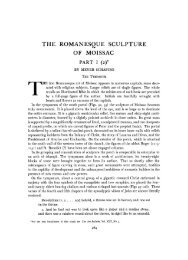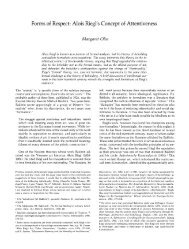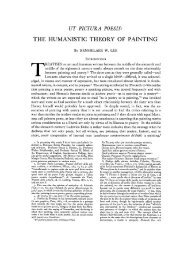Tragic Pompeii - College Art Association
Tragic Pompeii - College Art Association
Tragic Pompeii - College Art Association
You also want an ePaper? Increase the reach of your titles
YUMPU automatically turns print PDFs into web optimized ePapers that Google loves.
248 THE ART BULLETIN JUNE 1994 VOLUME LXXVI NUMBER 2<br />
frescoes within it conserved not just the memory of those<br />
stories, but traces of the styles of lost Greek or Hellenistic<br />
encaustic panels that had been created centuries earlier.<br />
Visual models, then, were projected into this space, transform-<br />
ing the domestic and ancestralfocus into an open reception<br />
hall, in this case, into a pinacotheca for the display of famous<br />
works of art.45<br />
An atrium is an unusual site for the highly valued mytho-<br />
logical panels, which are more often found in intimate dining<br />
rooms. Its decor may reflect the Roman private collections<br />
that became widespread, and were so hotly criticized by Latin<br />
writers, after the great pillaging of Greece in the second<br />
century B.c. Typical of the ambiguity of Roman painting,<br />
however, one cannot know if the frescoed simulation of the<br />
independent panels evoked a domestic collection or an<br />
elaborate display in a public portico or temple, if it indeed<br />
refers to another venue at all. Such collections, and the<br />
panels they contained, do not survive. In any case, the<br />
grandiose illusion surely enhanced the quasi-public role of<br />
the atrium as an area for family rituals as well as for the<br />
reception of business clients, and thus also the status of its<br />
owner. As has been amply demonstrated, the extroverted<br />
role of the paterfamilias (so brazenly enacted by Trimalchio)<br />
effected an elaborate iconography of domestic self-representation.<br />
It follows that a domestic pictorial display could be as<br />
programmatic or rich in content as one in the forum.46<br />
Roman fictional accounts of the reception of such paintings<br />
make no clear distinction between those seen in homes<br />
and those in public. Everywhere, images, and especially<br />
those of Greek pedigree, exerted powerful stimuli to memory<br />
and reverie. Petronius reminds us of the presence of old<br />
masterpieces, and even of paintings of romantic scenes, in<br />
mid-first-century Campania, the very period and setting of<br />
the House of the <strong>Tragic</strong> Poet. Entering a picture gallery in<br />
45 Vitruvius explicitly states, "Graeci atria non habebant" (6.7.1), and<br />
recommends spacious atria and pznacothecae only for men of rank with<br />
social obligations (6.5.2), trans. Morgan, 185, 182. On atria, see<br />
Wallace-Hadrill (as in n. 20), 166-170. The habit of decorating an<br />
interior with Trojan stories had a long history in Italy, one notable<br />
example being the Frangois Tomb in Vulci. A later literary parallel for<br />
the location of panels in the atrium occurs in Apuleius's Metamorphoses<br />
(6.24.2-3), trans. W. Adlington, rev. S. Gaselee, London, 1915, 291,<br />
when the heroine Charite vows to dedicate in her atrium a painted panel<br />
depicting her escape with Lucius the ass from the robbers' den; seen<br />
there, the triumphant scene stimulates discussion. On Trimalchio's<br />
collection: N. Slater, " 'Against Interpretation': Petronius and <strong>Art</strong><br />
Criticism," Ramus: Critzcal Studzes zn Greek and Roman Lzterature, XVl,<br />
1987, 165-176. On the Roman house as pznacotheca: A. W. van Buren,<br />
"Pinacothecae," Memoirs of the American Academy zn Rome, xv, 1938,<br />
70-81; Schefold (as in n. 22), chap. 1, II, 50-52: "La Maison comme<br />
pinacothbque." On memory and the museum, see W. Hooper-Greenhill,<br />
Museums and the Shaping of Knowledge, London, 1992, 91-104. The role<br />
of the Roman home as museum inspired the creation of theJ. Paul Getty<br />
Museum in Malibu, a re-creation of the Villa dei Papyri outside<br />
Herculaneum: N. Neuerburg, Herculaneum to Malzbu: A Companzon to the<br />
Vzszt oftheJ. Paul Getty Museum Building, Malibu, Calif., 1975.<br />
46 On the primary role of the paterfamilias in the domus, see Wallace-<br />
Hadrill, 44-97. On public collections, see R. Chevallier, L'<strong>Art</strong>zste, le<br />
collectzonneur, et le faussazre: Pour une soczologze de l'art romaine, Paris,<br />
1991, 132-177. For an idea of the complexity of multimedia displays in<br />
temples, see B. Kellum, "The City Adorned: Programmatic Display at<br />
the Aedes Concordiae Augustae," in Between Republzc and Empzre:<br />
Interpretatzons of Augustus and Hzs Prznczpate, ed. K. Raaflaub and M.<br />
Toher, Berkeley, 1986, 276-307.<br />
the "Greek town" on the Bay of Naples, Encolpius sees<br />
wondrous works by the greatest painters of the Classical<br />
period-Zeuxis, Protogenes, and Apelles-and begins to<br />
fantasize about the stories of the "painted lovers"; at one<br />
point, he even cries out.47<br />
Whereas contemporary writers like Petronius often isolate<br />
Greek signs within a Roman context, the story of the Trojan<br />
War, a legendary moment of confrontation and intersection<br />
between the two nations, blurred that distinction. The<br />
Romans had long claimed the Trojans as their ancestors, so<br />
that scenes of the paradigmatic war, even when represented<br />
in Greek texts or images, would be received by the Roman<br />
reader in a particularly relevant and immediate way. One<br />
thinks of Aeneas in Juno's sanctuary at Carthage, viewing<br />
scenes of the Trojan War that featured episodes of Achilles,<br />
all "set out in order": "With many tears and sighs he feeds his<br />
soul on what is nothing but a picture," and he begins a<br />
process of recollection, during which the events of his past<br />
life seem to come alive.48 Indeed, the entire Roman epic<br />
dramatizes the hero's moments of remembering and forgetting,<br />
and spatial order and the analogy to Homeric precedent<br />
play key roles in his retrieval.<br />
Plutarch reports an especially telling anecdote about the<br />
power of Homeric stories in paint. Porcia, trying to hide her<br />
despair at the impending separation from her husband,<br />
Brutus, breaks down upon seeing a painting of the parting of<br />
Hector and Andromache in Brundisium: "As Porcia looked<br />
at it, the image of her own sorrow which it conjured up made<br />
her burst into tears, and she went to see the picture time after<br />
time each day, and wept before it. On this occasion Acilius,<br />
one of Brutus's friends, quoted the verses from Homer which<br />
Andromache speaks to Hector: 'Hector, to me you are all:<br />
you have cared for me as a father, mother, and brother and<br />
loving husband. . .' (Iliad vi.429-430). Brutus smiled at him<br />
and said, 'But I shall not give Porcia the answer that Hector<br />
gave.'"49 The passage captures well the intensely personal,<br />
internal response of the viewer, Porcia, and also the game of<br />
47 Satyricon 83, trans. Sullivan, 92-93. C. Jones, "Dinner Theater," in<br />
Dzning in a Classical Context, ed. W. Slater, Ann Arbor, 1991, 185,<br />
acknowledges the danger of using Petronius's fictional text as a window<br />
onto Roman society, but sees value in the exercise. On the mix of "high"<br />
forms of literary allusion and "low" modes of popular art in the Satyrzcon,<br />
see J. Bodel, "Trimalchio's Underworld," in The Search for the Anczent<br />
Novel, ed.J. Tatum, Baltimore and London, 1994, 237-259.<br />
48Aenezd 1.658-700 (as in n. 40), 16-18. On the ongoing "Banquet of<br />
Homer" and the Trojan War as a paradigm of social relations: Plato,<br />
Republzc, 10, trans. G. M. A. Grube, Indianapolis, 1974, 239-263;<br />
Strabo, Geographia 1.2.8, trans. H.L. Jones, Cambridge, Mass. (1917),<br />
repr. 1969, 67-71; J. Overbeck, Dze Bildwerke zum thebzschen und trozschen<br />
Heldenkrezs, Stuttgart, 1857; K. Bulas, Les Illustrations antzques de l'Ilzade<br />
(EVS Supplementa, III), 1929; F. Bomer, Rom und Troza: Untersuchungen<br />
zur Fruhgeschichte Roms, Baden-Baden, 1951; K. Schefold, "Die Troiasage<br />
in Pompeji," Nederlands Kunsthistorzsch Jaarboek, v, 1954, 211-223; E.<br />
Gruen, Culture and Natzonal Identzty zn Republzcan Rome, Ithaca, N.Y.,<br />
1992, chap. 1. On its special popularity in the Neronian period: J. M.<br />
Croisille, Podsie et art figurd de Niron aux Flavzens. Recherches sur<br />
l'iconographze et la correspondance des arts a l'dpoque zmpirzale (Collectzon<br />
Latomus, CLIIIX), Brussels, 1982; F. Gury, "La Forge du Destin: A propos<br />
d'une serie de peintures pompeiennes du IV style," Milanges de l'Ecole<br />
Franfazse de Rome. Antzquztd, xcvII, 1986, 427-489, esp. 485-486.<br />
49 Brutus 23, in Makers of Rome: Nzne Lzves by Plutarch, trans. I.<br />
Scott-Kilvert, Middlesex, 1965, 242-243. Ann Kuttner alerted me to this<br />
passage.










